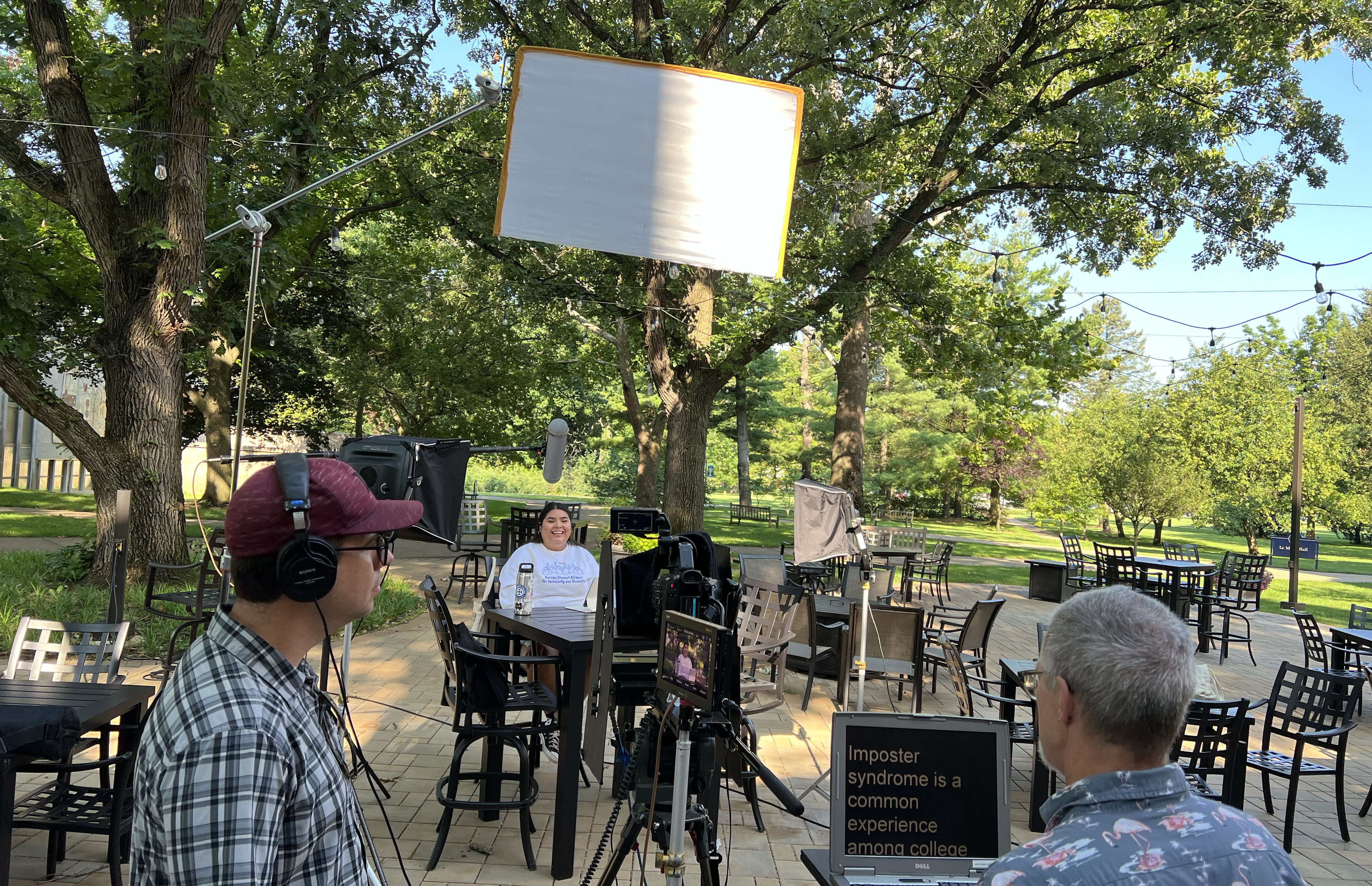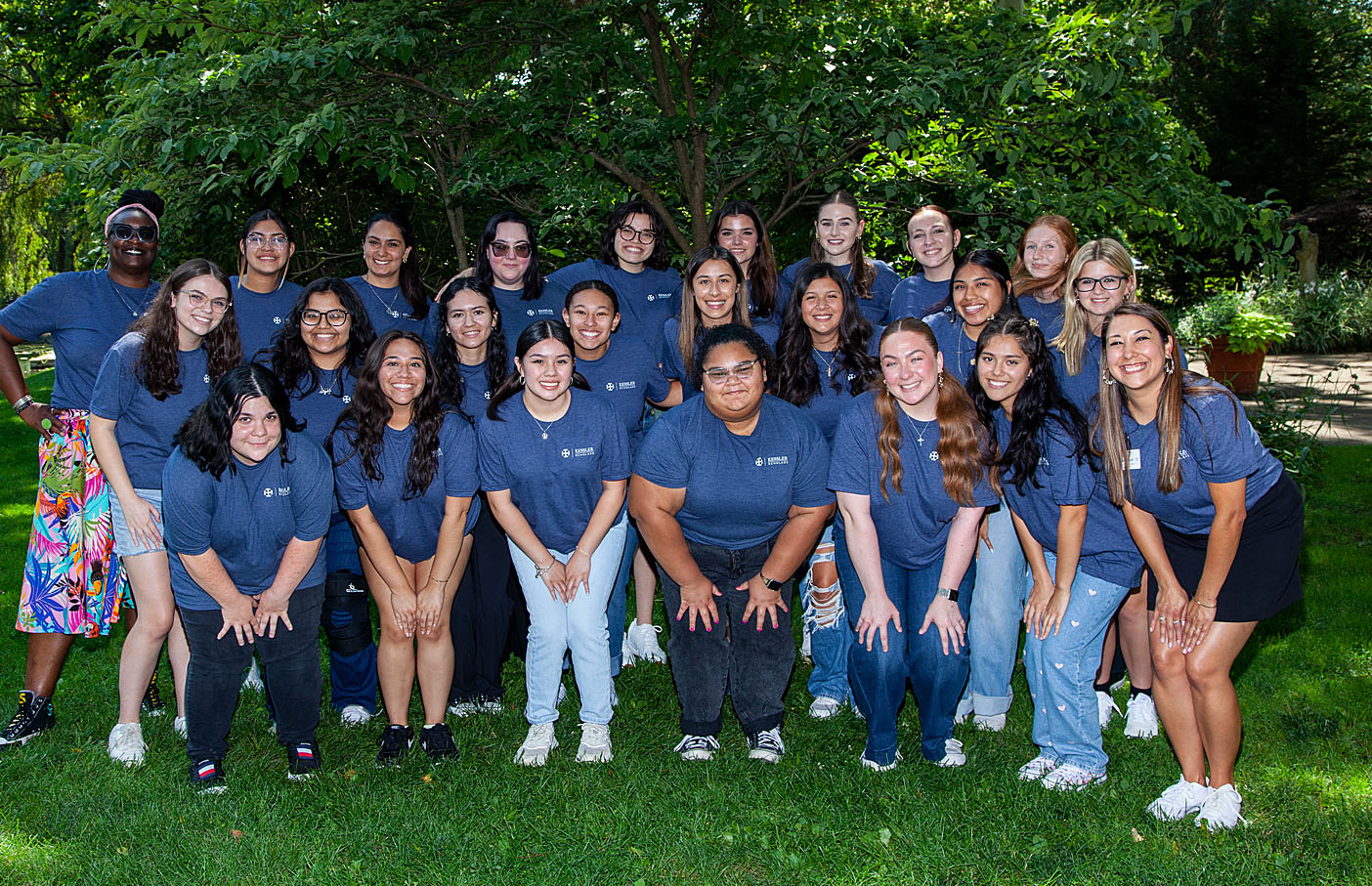Saint Mary’s Fights Back Against Racism
Saint Mary's Stories
By Kathe Brunton
In recent decades, the murders of Black people at the hands of law enforcement have created sparks of anger and discontent. But with the murder of George Floyd on May 25, those sparks raged into a fire that was fueled by additional deaths.
Following the incident in Minneapolis, Minnesota with Floyd, Saint Mary’s social media accounts were flooded with requests from students and alumnae to “do something!” With planning already in the works, President Conboy and her Cabinet keenly heard the pleas, knowing that the upcoming months would require not only specific and direct action, but a philosophical shift in hearts and minds as well.
The stand against racism
On June 1, the College Cabinet began by drafting a statement to reiterate and strengthen its commitment to stand against racism. President Katie Conboy—on the first day of her new role—directed the statement’s creation, which invites and challenges the entire College community to commit to a number of actions intended to enlighten, engage, inspire, and effect lasting change. This statement charges everyone—faculty, staff, students, and alumnae—to pull together to bring about fundamental shifts. Conboy realizes that this is no small challenge.
Redgina Hill, executive director of inclusion and equity, is helping to lead this charge. She points out that success or failure in this endeavor relies on every person being willing to take a fresh look at themselves, what they observe around them, and the courage to make a stand. Too often, efforts fail in organizations because the onus is put on the shoulders of one person. “Success is much greater when everyone owns the responsibility,” Hill said. “We are striving to weave our efforts in diversity, equity, inclusion, and justice into the fabric of our institution.”
The seven important actions outlined by the commitment statement are both tangible and intangible. They include engaging in continuous learning to understand the challenges of communities impacted by racial injustice. The statement nudges the College community to develop an awareness of their own biases and work toward overcoming them, as well as calling out racism wherever they see it. It is vital, too, to honor the experiences of others by listening to, and validating their narratives, and fostering friendships with people from diverse backgrounds.
The College also has committed to supporting organizations that are addressing issues surrounding racism, like the South Bend-Elkhart Regional Partnership (SBERP). Still in the planning stages, this and other partnerships may involve campus events or the College participating in the organizations’ activities. “We will walk alongside them to raise the banner for diversity, equity, inclusion, and justice,” said Hill.
In the statement’s final directive, the College encourages individuals to support policies and laws at the federal, state, and local levels that address disparities in educational opportunities, health care, housing, and law enforcement.
These seven directives—connected to Saint Mary’s mission and core values of learning, community, faith/spirituality, and justice—form a foundation for shifting hearts and minds as we journey down the path toward a more just campus and world.
Granted, this path will be long and it may not have a true end point, but the College will continually gauge its progress, because it is not enough to just ‘do’; one must also monitor and measure, and adjust as needed. “Accountability is key to the success of our commitment,” Hill said. “We have set measurable goals for the College’s new strategic plan, which includes a significant section on diversity, equity, inclusion, and justice.”
Educating and empowering
The Cabinet’s Stand on Racism was quickly followed by an open letter from the Board of Trustees later that week. In it, they outline additional commitments of the College including open dialogue. Beginning last June, Hill and President Conboy held a series of virtual town halls among faculty and staff, alumnae, students of color, alumnae of color, and faculty and staff of color.. The latter were asked to share their experiences at Saint Mary’s. “The shared narrative that has lived on throughout the generations of alumnae and current students is heartbreaking,” said Hill. “It was difficult to hear that someone who just graduated in 2020 had similar experiences as someone who graduated in the 1950s or 1970s. We have to do better at educating our College community, advocating for our students, and implementing structural changes that will enhance the climate for inclusion on our campus.”
Hill also brought to campus (virtually) last summer a five-week anti-racism journey that she co-facilitated with President Conboy. Each week, approximately 140 participants were provided with exposure to pertinent movies, documentaries, podcasts, and articles, then asked to follow a five-step plan: Watch. Read. Listen. Pray. Discern. At the end of each week, Hill and/or President Conboy moderated a discussion among the participants, who reflected on the current reading or viewing. Much of the material provided was uncomfortable at the least and gut-punch visceral at the most.
After watching the documentary called “13th” one participant told Hill, “I had several ‘Aha!’ moments about the ‘war on drugs.’ This has been so eye-opening. Understanding how the 13th amendment has led to another form of slavery breaks my heart.”
By week three, faculty and staff members began commenting that this educational journey was prompting them to question how they talked, what they celebrated, and even how they instructed. Multiple participants began to discuss what they might do differently at work and in the classroom. Many also were sobered to learn that attitudes and actions they thought were acceptable are now being challenged. Professors who attended the five-week journey also reflected that they now have a more critical take on how to approach their pedagogy in the classroom.
Removing barriers
 Some organizations might find it tempting to increase the number of diverse people within their walls and call their diversity effort solved. While it is true that the College welcomes greater diversity among faculty, staff, and the student body, as Hill notes, “Compositional diversity is not enough and can be extremely dangerous if we are not willing to address the issues that cause students to experience racism or feel excluded. We have to be unafraid to change the culture for all to experience belonging.”
Some organizations might find it tempting to increase the number of diverse people within their walls and call their diversity effort solved. While it is true that the College welcomes greater diversity among faculty, staff, and the student body, as Hill notes, “Compositional diversity is not enough and can be extremely dangerous if we are not willing to address the issues that cause students to experience racism or feel excluded. We have to be unafraid to change the culture for all to experience belonging.”
During the five-week antiracism journey, some faculty members were inspired to review their curriculum to be more inclusive
“We are looking at the barriers that are in place that are potentially keeping some students from feeling included,” Hill said.
“We want to see how we can be more inclusive in our curriculum in bringing in voices and faces, different ethnicities that may not be already represented here. Plus, the learnings that we gained from the five-week anti-racism journey have created traction for more training for faculty, staff, administration, and the board.”
Training is currently being planned for the campus.
Hill is also engaging the President’s Council on Inclusivity and Multicultural Diversity (PCIMD) in this commitment. Vital to sustaining Saint Mary’s commitment against racism, the PCIMD is a long-standing advisory and leadership team—comprising Cabinet-level administrative members, faculty, staff, and student leaders—that develops, oversees, and monitors College-wide efforts on inclusivity and multicultural diversity. Hill chairs
the council.
Learning from our past
It is difficult to reflect on the nearly 70 years that have passed since the first woman of color, Juanita Boozer Bay, graduated from the College in 1952. Today, in 2020, women of color at the College represent 22 percent of enrollment. But, as Hill said, and as alumnae reminded us, compositional diversity is not enough.
Just because more women of color choose Saint Mary’s does not mean they will not experience subtle or not-so-subtle moments of racist attitudes.
For those alumnae who do not believe that racism has existed and still occurs on campus, Hill recommends they pay attention to the narratives of those who have lived it. “Connect to your local alumnae base or your class year, because you likely will find someone within your class, someone who lived in your dorm or that you had a class with or ate with in the dining hall, who probably had some negative experiences,” she said. “Reach out among your classmates and ask to have a conversation about their time at Saint Mary’s, then listen and don’t invalidate their experience.”
The focus as the College moves forward, however, is not to lay blame, but to chart a course for effecting long-term sustainable and measurable change with the goal of eliminating racist attitudes and misbeliefs, of changing hearts and minds.
Hill said she has been excited at seeing the “many light bulbs that went on for so many people” during the five-week journey and through other activities. To see this enlightenment translated into the new school year, its impact on how faculty approach the classroom, and even how individuals approach conversations,
“I feel good that we are moving in the right direction.”
This “right direction” is an ongoing effort for Saint Mary’s—and the rest of the world. There won’t be a finish line to this work, rather a sustained awareness and active education for the current campus community and all the generations to follow. It means the College must always lead the exploration of biases, learned behaviors, and lack of awareness of those who step onto these beloved grounds. But it also means that the College must encourage our larger communities to do that same—including our alumnae who live around the world.
Get Involved
Saint Mary’s invites you to join the College in the fight against racism. Online, you’ll find the five-week antiracism educational journey, Our Stand Against Racism from the Cabinet, and the Trustees’ open letter with the College’s commitments to take sustained action. You’re encouraged to review and adopt these tools into discussions with friends and family, in your workplace, and everywhere you interact with others. It is no small feat to make the world a just and inclusive place but by broadening perspectives, Saint Mary’s hopes to help make an impact on campus and in our communities.
- 5 Week Educational Journey
- Anti-Racism Learning Resources
- Our Stand Against Racism
- Open Letter to the College



